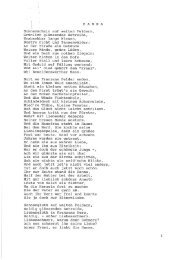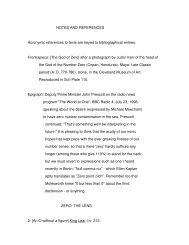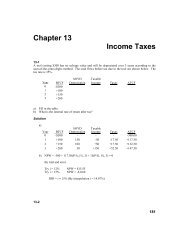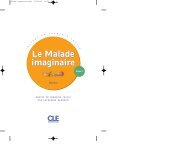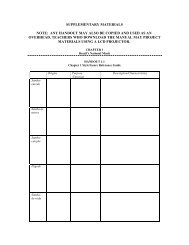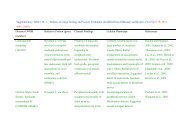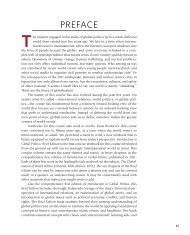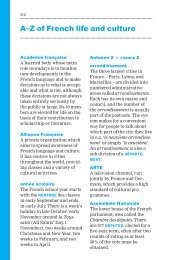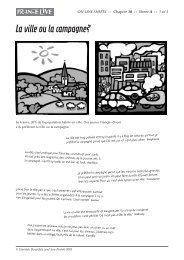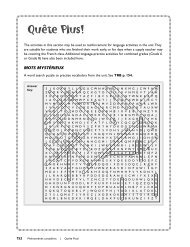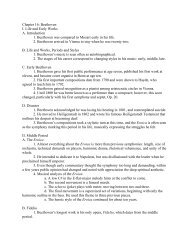CHAPTER 3 Consumer Preferences and Choice
CHAPTER 3 Consumer Preferences and Choice
CHAPTER 3 Consumer Preferences and Choice
Create successful ePaper yourself
Turn your PDF publications into a flip-book with our unique Google optimized e-Paper software.
03-Salvatore-Chap03.qxd 08-08-2008 12:41 PM Page 77<br />
Corner solution<br />
Constrained utility<br />
maximization with the<br />
consumer spending<br />
all of his or her income<br />
on only one or some<br />
goods.<br />
<strong>CHAPTER</strong> 3 <strong>Consumer</strong> <strong>Preferences</strong> <strong>and</strong> <strong>Choice</strong> 77<br />
as to the ability of various goods to satisfy their wants—see M. Shodell, “Risky<br />
Business,” Science, October 1985.<br />
The effect of the government warning can be shown with dashed indifference<br />
curves U ′ 0 <strong>and</strong> U ′ 1. Note that U ′ 0 is steeper than U1 at than original optimization point<br />
B, indicating that after the warning the individual is willing to give up more sodas for<br />
an additional container of milk (i.e., MRSXY is higher for U ′ 0 than for U1 at point B).<br />
Now U ′ 0 can intersect U1 because of the change in tastes. Note also that U ′ 0 involves<br />
less utility than U1 at point B because the seven sodas (<strong>and</strong> the three containers of<br />
milk) provide less utility after the warning. After the warning, the consumer maximizes<br />
utility by consuming six containers of milk <strong>and</strong> only four sodas (point B ′ ,<br />
where U ′ 1 is tangent to the budget line).<br />
The above analysis clearly shows how indifference curve analysis can be used to<br />
examine the effect of any government warning on consumption patterns, such as the<br />
1965 law requiring manufacturers to print on each pack of cigarettes sold in the United<br />
States the warning that cigarette smoking is dangerous to health. Indeed, the World<br />
Health Organization is now stepping up efforts to promote a global treaty to curb cigarette<br />
smoking. We can analyze the effect on consumption of any new information by<br />
examining the effect it has on the consumer’s indifference map. Similarly, indifference<br />
curve analysis can be used to analyze the effect on consumer purchases of any regulation<br />
such as the one requiring drivers to wear seat belts.<br />
Sources: “Some States Fight Junk Food Sales in School,” New York Times, September 9, 2001, p. 1; <strong>and</strong><br />
“Companies Agree to Ban on Sale of Fizzy Drinks in Schools,” Financial Times, May 4, 2006, p. 6.<br />
Corner Solutions<br />
If indifference curves are everywhere either flatter or steeper than the budget line, or if<br />
they are concave rather than convex to the origin, then the consumer maximizes utility by<br />
spending all income on either good Y or good X. These are called corner solutions.<br />
In the left panel of Figure 3.10, indifference curves U0, U1, <strong>and</strong> U2 are everywhere<br />
flatter than budget line JK, <strong>and</strong> U1 is the highest indifference curve that the consumer can<br />
reach by purchasing 10Y <strong>and</strong> 0X (endpoint J). Point J is closest to the tangency point,<br />
which cannot be achieved. The individual could purchase 2X <strong>and</strong> 6Y <strong>and</strong> reach point B,<br />
but point B is on lower indifference curve U0. Since point J is on the Y-axis (<strong>and</strong> involves<br />
the consumer spending all his or her income on good Y), it is called a corner solution.<br />
The middle panel shows indifference curves that are everywhere steeper than the<br />
budget line, <strong>and</strong> U1 is the highest indifference curve that the consumer can reach by<br />
spending all income to purchase 5X <strong>and</strong> 0Y (endpoint K). The individual could purchase<br />
1X <strong>and</strong> 8Y at point L, but this is on lower indifference curve U0. Point K is on the horizontal<br />
axis <strong>and</strong> involves the consumer spending all his or her income on good X, so<br />
point K is also a corner solution.<br />
In the right panel, concave indifference curve U1 is tangent to the budget line at point<br />
B, but this is not optimum because the consumer can reach higher indifference curve U2<br />
by spending all income to purchase 10Y <strong>and</strong> 0X (endpoint J). This is also a corner solution.<br />
Thus, the condition that an indifference curve must be tangent to the budget line for



